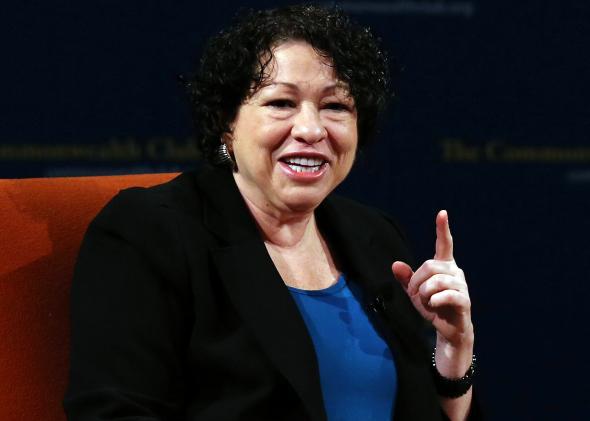Thank you so much for including me in this year’s discussion. Dahlia, you asked about the First Amendment cases. I think it was Dante who said a great flame follows a little spark. Whoever said it, it’s true: Seemingly small cases sometimes open big windows.
That’s why I’d like to begin my stint at the Breakfast Table not with one of this week’s much-anticipated blockbusters but with a little case decided a few days ago called Lane v. Franks. In Lane, a unanimous court nipped in the bud some of the scariest implications of the 2006 Garcetti v. Ceballos decision, at least slowing down the court’s dismantling of the free speech rights of public employees.
Nobody was surprised that this court—despite decisions clipping the First Amendment wings of various vulnerable groups (including students, prisoners, and human rights activists)—protected Edward Lane. His employer, a community college in Alabama, had fired him for testifying truthfully in response to a subpoena in a federal criminal trial dealing with mail fraud and theft by one of Lane’s erstwhile subordinates.
It was mildly interesting that, in her first written opinion about free speech rights, Justice Sotomayor sang the praises of public employee speech much as the Garcetti dissenters had done. Justice Sotomayor has voted on the free speech side of every major Roberts Court decision outside campaign finance since joining the court. She did so once, in Sorrell v. IMS, even when it meant joining the conservative wing over the dissenting votes of Ginsburg, Breyer, and Kagan—all of whom would have upheld the Vermont drug price regulation struck down on First Amendment grounds in that case and all of whom worried that the six-justice majority was resurrecting old-style review of any economic regulation that controlled the flow of information.
Sotomayor’s pro-speech position in Lane did leave her plenty of room to reject free speech claims when pitted against weighty enough countervailing rights and interests in the abortion buffer zone and public employees’ union cases slated to come down soon after Lane. For those reasons and more, Lane looked to most observers like small potatoes, too small to be worth talking about over breakfast. But, as I said at the start, I think the small cases sometimes give us a revealing peek at big vistas.
The “big vista” I think Lane exposed involved Justice Sotomayor’s willingness to continue and maybe even accelerate the Roberts Court’s march toward making one right after another harder to enforce—whether through class actions, or through litigation rather than arbitration, or even through the mechanism expressly provided by Congress in Section 1983, which allows people to sue the government for civil rights violations.
In Section 1983 cases, the government often wins based on “qualified immunity,” a judicially invented doctrine giving state and local government officials an increasingly ironclad defense against ever having to say they’re sorry—a defense against being held accountable through awards of damages to those whose rights they violate. The immunity shield works by enabling those officials to plead uncertainty in the law making their acts unconstitutional. Such “uncertainty” is sadly becoming ever easier to establish. So in Lane, Justice Sotomayor led a unanimous court in holding that, though there’s “no doubt” that Lane’s testimony was “entitled to First Amendment protection,” mixed signals from a series of previous decisions entitled Franks to argue that he could “reasonably have believed that it was lawful to fire Lane in retaliation for his testimony.”
That’s a head-scratcher if I ever saw one.
Even if we forget about the First Amendment, who could forget the Supremacy Clause, which requires state judges to follow federal law, and the long line of decisions protecting federal institutions from state attack? These decisions date all the way back to the rulings in McCulloch v. Maryland in 1819 that Maryland couldn’t tax the Bank of the United States and in In re Neagle in 1890 that California couldn’t arrest a federal marshal for doing his job of protecting a Supreme Court justice’s life. Here, it wasn’t just one federal judge that Alabama was messing with when Franks, a state official, fired his employee for testifying truthfully in a federal criminal trial. It was the core function of the federal judiciary itself in “say[ing] what the law is,” to quote Marbury, and of the federal executive in enforcing that law through criminal prosecution.
I liked and agreed with Marty Lederman’s post on Lane, in which he elaborated this oddly overlooked facet of the case and identified some federal laws going back to the 1870s prohibiting adverse job actions designed to influence testimony in a federal trial, but I’m not as ready as Marty was to excuse the court’s failure to bring this structural point up on its own. The excuse Marty offered was that this basic ban on actions interposing state authority to obstruct the full enforcement of federal laws hadn’t been presented in the pleadings. As if this court has never been known to broaden the lens of its inquiry when doing so would nudge the law in a direction the majority deemed important!
Something this basic—something making it obvious that Franks had acted illegally when he fired Lane—would’ve been easy to bring within the court’s gaze if the justices shared my worry about closing off one avenue of civil rights relief after another, a worry I discuss in the last chapter of a recently published book, Uncertain Justice: The Roberts Court and the Constitution.
